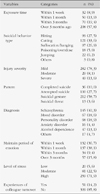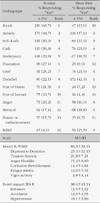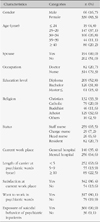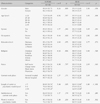Abstract
Purpose
In this study, emotional reaction of psychiatric nurses and resident physicians toward suicidal behavior of psychiatric inpatients was examined.
Methods
Subjects were 396 working in general hospitals or mental hospitals. Demographic factors, exposure to suicidal behaviors, mood states, and impact of event scores were collected between April and July 2008. Mood state was measured with Korean Edition of Profile of Mood States (K-POMS). Impact of event was measured with Impact of Event Scale-revised (IES-R).
Results
Of the respondents, 90.9% experienced at least one inpatient suicidal behavior. Emotional responses of respondents after their patients' suicidal behavior were shock, anxiety, self-doubt and disbelief. Mood states were negative for those who had worked over 10 years, had experienced colleagues quitting and were significantly different according to patient's diagnosis, period of maintaining emotions, and level of stress. Impact of event was high among those who were nurses, had worked in mental hospitals, had worked over 10 years, had experienced colleagues quitting and were significantly differenced according to job status, patient's diagnosis, period of maintaining emotion, and level of stress.
Figures and Tables
Table 2
Experience of Suicidal Behavior of Psychiatric Inpatients by Psychiatric Nurses and Resident Physicians (N=360)

Table 3
Emotional Responses among Psychiatric Nurses and Resident Physicians after Suicidal Behavior of Inpatients (N=360)

References
1. Alexander DA, Klein S, Gray NM, Dewar IG, Eagles JM. Suicide by patients: Questionnaire study of its effect on consultant psychiatrists. BMJ. 2000; 320:1571–1574.

2. Anderson M, Standen PJ. Attitudes towards suicide among nurses and doctors working with children and young people who self-harm. J Psychiatr Ment Health Nurs. 2007; 14:470–477.

3. Bowers L, Simpson A, Eyres S, Nijman H, Hall C, Grange A, et al. Serious untoward incidents and their aftermath in acute inpatient psychiatry: The Tompkins acute ward study. Int J Ment Health Nurs. 2006; 15:226–234.

4. Combs H, Romm S. Psychiatric inpatient suicide: A literature review. Prim psychiatry. 2007; 14:67–74.
5. Dong JY, Ho TP, Kan CK. A case-control study of 92 cases of inpatient suicides. J Affect Disord. 2005; 87:91–99.

6. Erlangsen A, Zarit SH, Tu X, Conwell Y. Suicide among older psychiatric inpatients: An evidence-based study of a high-risk group. Am J Geriatr Psychiatry. 2006; 14:734–741.

7. Hendin H, Haas AP, Maltsberger JT, Szanto K, Rabinowicz H. Factors contributing to therapists' distress after the suicide of patient. Am J Psychiatry. 2004; 161:1442–1446.

8. Hendin H, Lipschitz A, Maltsberger JT, Haas AP, Wynecoop S. Therapist's reactions to patients'suicides. Am J Psychiatry. 2000; 157:2022–2027.
9. Hong HS. Impact of exposure to suicide of a family member on mental health of family: A one year follow-up study based on registers. Seoul: The Catholic University of Korea;2007. Unpublished master's thesis.
10. Horowitz M, Wilner N, Alvarez W. Impact of event scale: A measure of subjective stress. Psychosom Med. 1979; 41:209–218.

11. Hunt IM, Kapur N, Webb R, Robinson J, Burns J, Turnbull P, et al. Suicide in current psychiatric inpatients: A case-control study: The national confidential inquiry into suicide and homicide. Psychol Med. 2007; 37:831–837.

12. Jae YM. Suicide and psychiatric disorder. J Korean Soc Biol Ther Psychiatry. 2004; 10:3–10.
13. Jeon HJ, Lee JY, Lee YM, Hong JP, Won SH, Cho SJ, et al. Unplanned versus planned suicide attempters, precipitants, methods, and an association with mental disorders in a Korea-based community sample. J Affect Disord. 2010; 127:274–280.

14. Joyce B, Wallbridge H. Effects of suicidal behavior on a psychiatric unit nursing team. J Psychosoc Nurs Ment Health Serv. 2003; 41:14–23.

15. Jun CE, Hyun MH. The effects of shame, guilt, and social support on PTSD in psychological abused women. Korean J Clin Psychol. 2003; 22:763–776.
16. Kim EJ, Lee SI, Jeong DU, Shin MS, Yoon IY. Standardization and reliability and validity of the Korean edition of Profile Of Mood States. Sleep Med Psychophysiol. 2003; 10:39–51.
17. Knieper AJ. The suicide survivor's grief and recovery. Suicide Life Threat Behav. 1999; 29:353–364.
18. Kumar S. Burnout in psychiatrists. World Psychiatry. 2007; 6:186–189.
19. Lee GS, Seo YM, Nam EK, Kim DW, Kim JE, Lee MS. The survey of suicide related events in community mental health facilities in Seoul. Ment Health Serv. 2010; 1:18–25.
20. Lee HO, Lee K, Kohlman GCV. Reliability, validity, and cultural relevancy of the Korean version of the POMS. J Korean Acad Nurs. 1999; 29:1147–1154.

21. Lieberman DZ, Resnik HL, Holder-Perkins V. Environmental risk factors in hospital suicide. Suicide Life Threat Behav. 2004; 34:448–453.

22. McNair DM, Lorr M, Droppleman LF. Profile of Mood States Manual. San Diego: Educational & Industrial Testing Service;1992.
23. Park EY. The influencing factor on suicide attempt among adolescents in South Korea. J Korean Acad Nurs. 2008; 38:465–473.

24. Pieters G, De Gucht V, Joos G, De Heyn E. Frequency and impact of patient suicide on psychiatric trainees. Eur Psychiatry. 2003; 18:345–349.

25. Rathod S, Roy L, Ramsay M, Das M, Birtwistle J, Kingdon D. A survey of stress in psychiatrists working in the Wessex region. Psychiatr Bull. 2000; 24:133–136.

26. Ruskin R, Sakinofsky I, Bagby RM, Dickens S, Sousa G. Impact of patient suicide on psychiatrists and psychiatric trainees. Acad Psychiatry. 2004; 28:104–110.

27. Spiessle H, Hubner-Liebermann B, Cording C. Suicidal behaviour of psychiatric inpatients. Acta Psychiatr Scand. 2002; 106:134–138.

28. Sveen CA, Walby FA. Suicide survivors' mental health and grief reactions: A systematic review of controlled studies. Suicide Life Threat Behav. 2008; 38:13–29.

29. Weiss DS, Marmar CR. The impact of event scalerevised. In : Wilson JP, Keane TM, editors. Assessing psychological trauma and PTSD. New York: Guilford Press;1996. p. 339–411.




 PDF
PDF ePub
ePub Citation
Citation Print
Print





 XML Download
XML Download